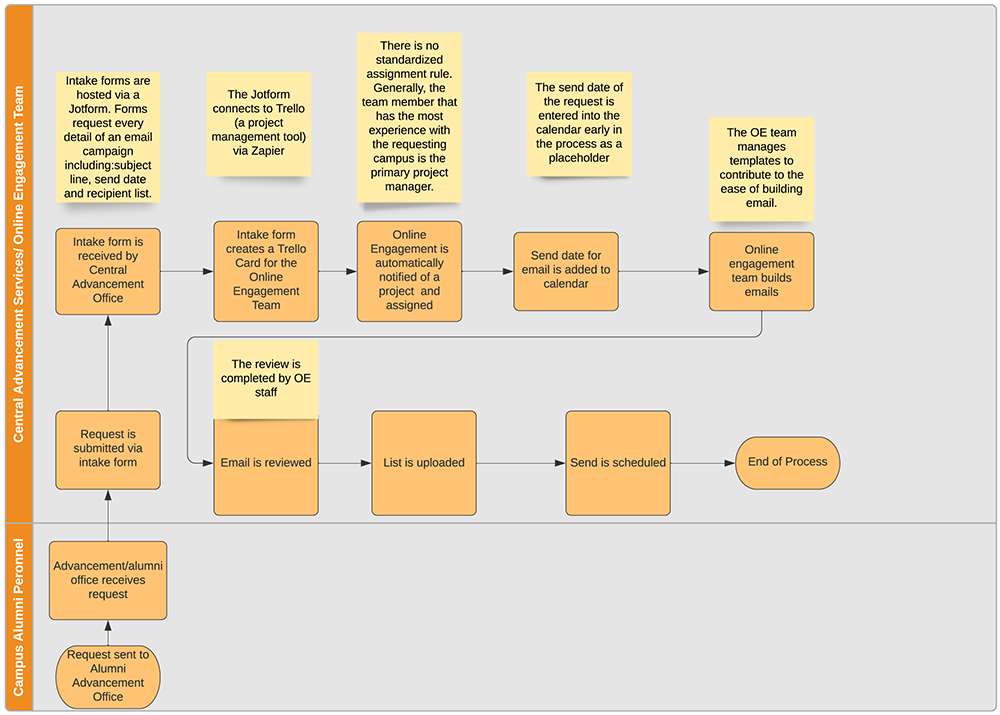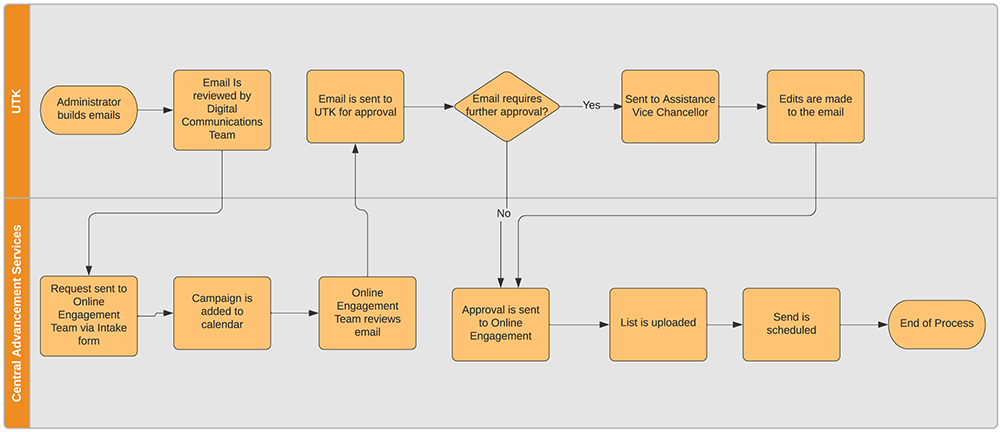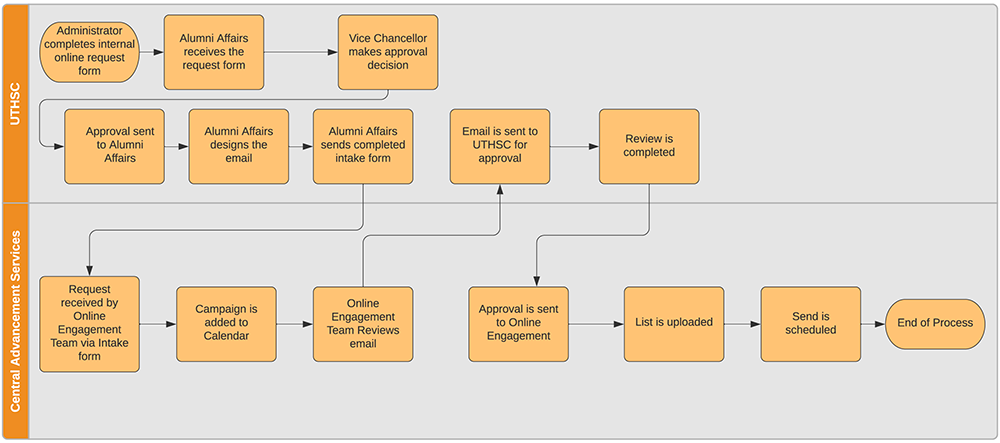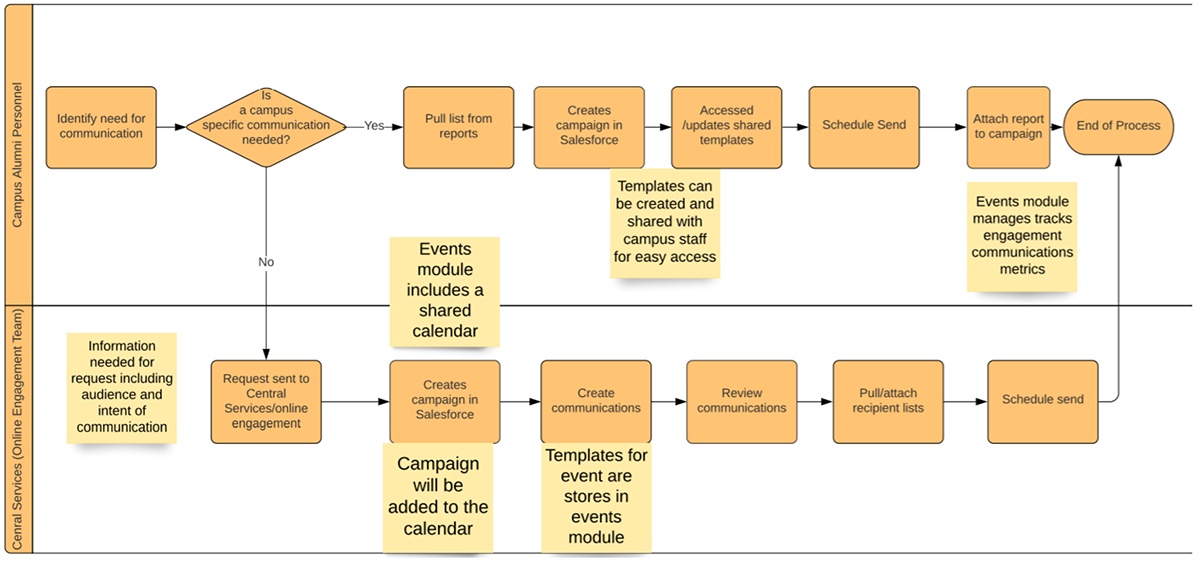Discovery Sessions
Process Overview
Communications campaigns involve the use of several processes, depending on which campus submits the request to initiate a campaign. The following stakeholders are involved in executing a communications campaign.
- UT Campus Departments (Internal)
- Central Services/Digital Strategy and Innovation (DSI) Team (Internal)
- Campus Alumni Office (Internal)
Generally, communication requests are sent to the Alumni office by a representative from the individual campus. After receiving the request, the Alumni office submits a JotForm to the online engagement team. The online engagement team hosts several types of forms: email, events and newsletters. Completion of the JotForm triggers a Trello card via the Zapier connection of the JotForm and Trello apps. (Trello is a project management tool that the DSI team uses to manage projects, such as email campaigns). Upon creation of a Trello card, all five members of the digital strategy and innovation team are notified.
The project is managed by the DSI team member who has the most experience with the campus initiating the request. Once the project is assigned, a send date is added to a centralized calendar of upcoming events and campaigns as a placeholder. A member of the DSI staff builds the email, and the requested communication is reviewed internally by DSI staff. Once the created email is approved by staff, the list of recipients is uploaded, and the email campaign is scheduled to be sent.
Some campuses do not follow the general process, due to campus administrators having the ability to generate their own emails for email campaigns. These campuses include UT Knoxville, UT Chattanooga and UT Health Science Center.
University of Tennessee, Knoxville administrators build their own emails, which are then reviewed by an internal digital communications team, who completes the JotForm supplied by the DSI Team. The DSI Team then adds the campaign to the centralized calendar, reviews the email and sends edits back to UT Knoxville for approval. Some emails require additional approval, and in those cases, the Assistant Vice Chancellor approves email communications. Once the campus approves the email, the approved communication is sent back to DSI. Once the DSI team receives the approved email, the recipient list is uploaded and the outbound communication is scheduled.
At the University of Tennessee at Chattanooga, campaigns are scheduled during quarterly and monthly meetings. After these meetings, administrators build emails, which are sent to the Donor Engagement team for approval. Once approved, Donor Engagement sends the emails to DSI in Central Services. The DSI team then adds the campaign to the centralized calendar, reviews the email and sends any email edits back to UT Chattanooga for approval. Emails requiring additional approval are sent to the Assistant Vice Chancellor to approve email communications. Once the campus approves the email, the approved communication is sent back to DSI. Once the DSI team receives the approved email, the recipient list is uploaded and the outbound communication is scheduled.
University of Tennessee Health Science Center follows a different process: an internal intake form is completed by administrators via iModules/Encompass. The form is received by the Alumni Affairs team, who then sends the request to the Assistant Vice Chancellor for approval. Once approved, the email is designed by the Alumni Affairs team, who then submits the JotForm, sending a campaign request to the DSI team. Once the email is scheduled and reviewed by the DSI team, the email is sent back to the campus for approval. If changes to the email require additional approval, the Assistant Vice Chancellor will review the email and send the approved version back to the DSI team. Once approval is received, the recipient list is uploaded and the email is scheduled to be sent.



Opportunities
During discussion about the process, several improvement opportunities to address inefficiencies in the current state surfaced:
1. Data Centralization
- Not all emails are created by the DSI Team.
- Different campuses follow different processes because administrators can create their own emails.
- Emails requiring additional approvals can prolong the process before email campaigns are sent.
2. Project Assignment
- Currently there is no standardized rule for assigning communications projects.
- Assignment rules can reduce the dependency on multiple apps like JotForm, Zapier and Trello to manage communications and project assignments.
3. Campaign Calendar
- The calendar could be improved by providing information about audiences.
- If audience information were provided, planned send dates for emails could be adjusted to reduce overlapping emails.
4. Subscription Preferences
- If a constituent unsubscribes from one type of communication, he or she is opted out of all communications; subscription preferences would allow for email recipients to choose the types of email communication they would like to receive, without removing them from all communications.
5. Reporting
- Depending on which Central IT staff member generates the recipient list, a different constituency is produced based on their specific process for generating the list or knowledge of the data set.
- There are no standardized segmentation rules
- Currently, event communications are not facilitated by specific campaigns or comprehensive communications strategies.
- Emerging changes in the industry related to privacy (e.g., Apple email privacy capabilities) can impact reporting; this includes functions like masking emails, which obscure information regarding open rates and engagement.
- Non-Alumni donors are not loaded into ANDI.
6. Analytics
- Predictive analytics functionality is lacking.
- Campaigns would benefit from insights to reengage, to create personas or attribute-based journeys/communications, or actions taken in previous emails
7. Multi-Channel Communications
- Currently email is the sole channel for campaign communications.
- Campaigns could benefit from the use of multiple communication channels, i.e., SMS messaging.
Final Summary
The analysis shows that the current process possesses inefficiencies focused on standardization of data retrieval processes, availability of audience information, lack of analytical functionality, individualization of communication preferences, and lack of multi-channel communications. Standardization of data retrieval processes would produce consistency and reliability of data. In addition, non-alumni donor opportunities are lost because ANDI does not house data on non-alumni donors. Furthermore, a time-lag exists concerning the validity of data, due to the updates not being loaded into the recipient list between the time the data is generated and the actual send-date of communications.
Having comprehensive, centralized, real-time data in Salesforce will eliminate the time lag. Reliable data and standardization will also address the problem of reliance on the personal knowledge of the person generating recipient lists. Moreover, staff retirements will no longer be a hindrance, as standardized retrieval practices will reduce reliance on personal knowledge and bring uniformity to the process. More robust analytics and audience insight could improve targeting, timing and personalization of communications. Additionally, not tracking subscription preferences negatively impacts the ability to communicate with constituents. If a donor unsubscribes from one email or newsletter, the result is that they completely opt out of all communication instead of being able to provide information on the ways they would most like to receive advancement communications.
The inability to customize communication preferences is also related to the limited communication channels used by Advancement. Currently, email is the sole communication channel, but Salesforce Marketing Cloud will allow for the ability to build interest profiles, customer journeys and roll out multi-channel communications planning.
Future State Process Overview
Communication requests will be initiated by each campus’ Alumni office, who will determine if communications are intended to satisfy a campus-specific need.If the communication is campus specific, the alumni office will generate recipients from a list of standard segmentation reports. Segmentation parameters can be defined prior to go-live, during the implementation process. Campus personnel will have access to share email templates and have the ability to create communications campaigns in Salesforce. During the communication creation, the recipient list will be indicated, along with the desired send date. Centralized communications calendars will allow for the coordination of communications across campuses, as well as across initiatives/campaigns on a particular campus.
If the communication is not campus-specific, alumni personnel will request that the DSI produce the campaign. The DSI team will create a campaign in Salesforce and generate the appropriate invitee list, based on the request of the originating campus. The DSI will create the communication piece, review and attach approved emails to the campaign, and schedule the send date to the appropriate recipient list.
All communications will be tracked in Salesforce and engagement information will be available for view on the constituent’s record. Real-time insights will be available to determine the impact of a particular or group of communication campaigns.
Key Changes
During discussion about the process, several improvements to current inefficiencies were identified:
1. Communications Coordination/Centralization
- Currently, not all emails are created by the DSI Team.
- In the future, approved email templates will be housed in a shared templates folder.
- Presently, campuses follow different campaign planning and execution processes, allowing administrators to create their own emails.
- In the future, administrators will be able to review, update and attach templates to campaigns for campus specific communication. Wider reaching campaigns will require assistance from the OET.
- Currently, some recipient lists are built with information from outside the ANDI system.
- In the future, Salesforce will house all data and email templates.
- A central communications calendar will allow for increased coordination of communications.
2. Project Assignment
- Currently, there is no standardized rule for assigning communications projects, and multiple external systems are used to execute campaigns and track project management functionality.
- In the future, the creation of assignment rules will reduce the dependency on apps like JotForm, Zapier and Trello, which are currently used to manage communications and project assignments.
3. Subscription Preferences
- Currently, constituent subscription preferences are not comprehensive and result in constituents opting out of more than they had potentially intended.
- In the future state, email recipients will be able to comprehensively communicate their subscription preferences. This will enable communications staff to honor the specific wishes of constituents.
4. Reporting
- Currently, depending on which Central IT staff member generates the recipient list, a different constituency is produced based on their specific process for generating the list or knowledge of the data set.
- In the future, segmentation at least 80% of the audience segmentations will be predefined and housed I shared reports, following standardized segmentation rules.
- Currently, non-alumni donors are not loaded into the system.
- In the future, Salesforce will add the ability to track communications to non-alumni donors via reporting functionalities native to the system.
5. Analytics
- Currently, predictive analytics are not employed in communication campaigns.
- In the future, audience insights will assist in re-engagement activity, provide for the creation of personas or attribute-based journeys/communications, experience tracking and robust tagging functionality.
6. Multi-Channel Communications
- Currently, email is the sole channel for campaign communications.
- In the future, campaigns will benefit from the functionality of multi-communication channels, i.e., SMS messaging.
Considerations
- What data would you like to use to drive segmentation in the future?
- Who will be able to create a communication campaign in the future? Who will create communication templates/content?
- What communication engagement information would you like visible directly on the constituent’s record?
- What uses for dynamic content and automated communications journeys would you like to explore first?
Final Summary
The current system possesses inefficiencies surrounding standardization of data retrieval processes, availability of audience information, lack of analytical functionality, individualization of communication preferences and lack of multi-channel communications. Standardization of data retrieval processes will produce consistency and reliability of data. Non- alumni donor opportunities will no longer be lost because of the new ability to house non-alumni donor data in Salesforce. Real-time data availability will add integrity to the data retrieval process, eliminating the time lag between data retrieval and the send date of communications.
Standardization of the data retrieval process will also address the problem of reliance on personal knowledge to generate recipient lists, bringing uniformity to the process. More robust analytics and audience insights will improve personalization of communications. Additionally, tracking subscription preferences will improve communications, by ensuring communications are targeted to the appropriate constituents. Currently, email is the sole communication channel, but Salesforce Marketing Cloud will provide the ability to build interest profiles, customer journeys and roll out multi-channel communications planning.


